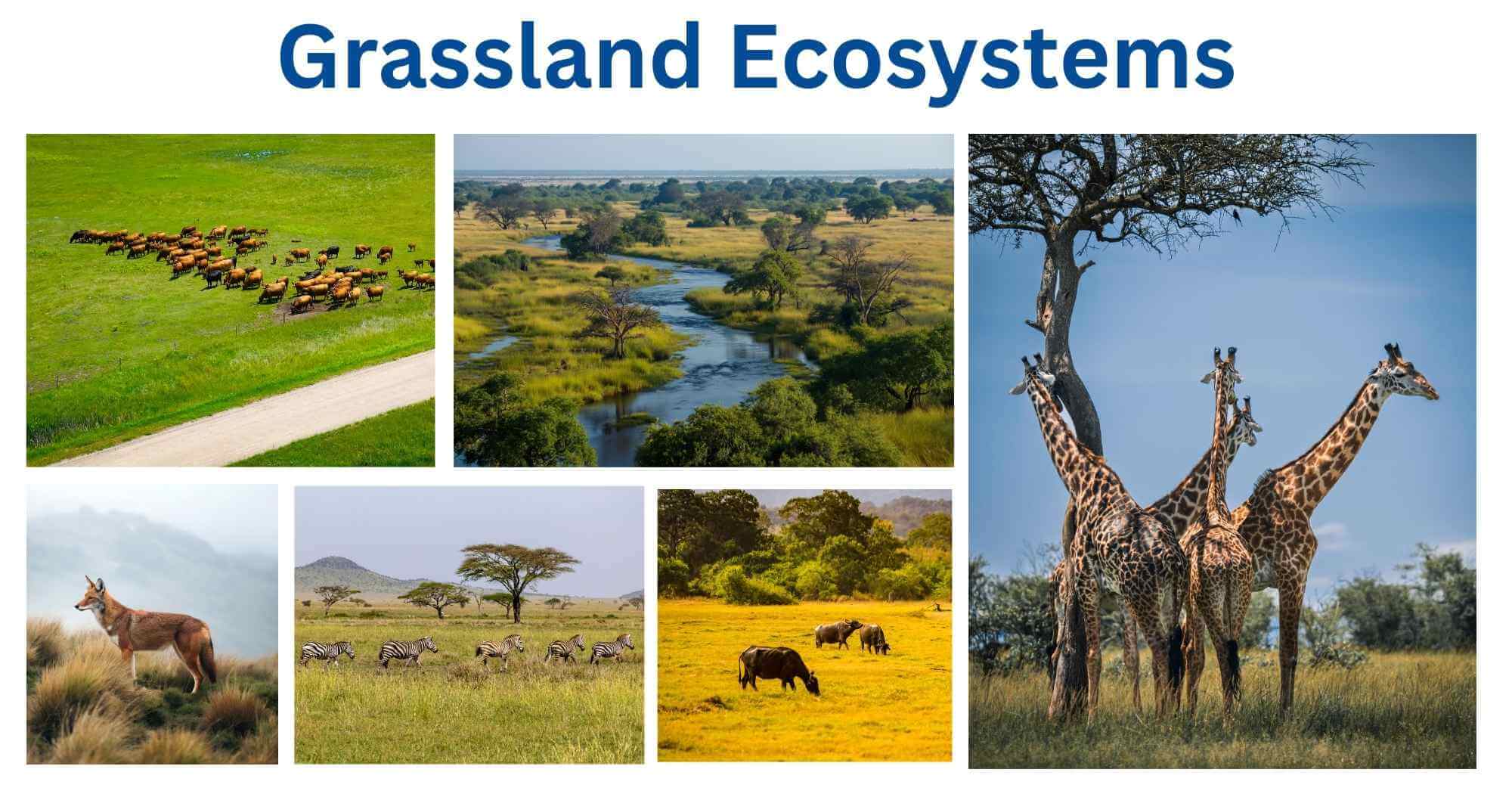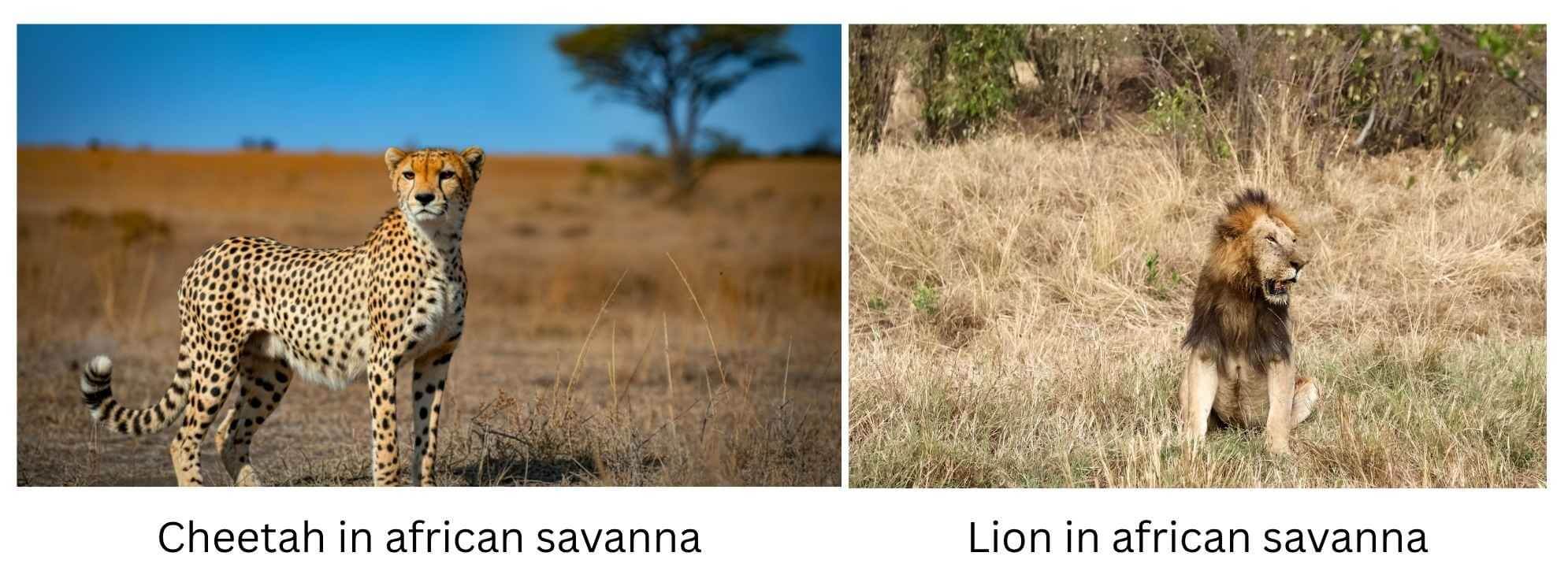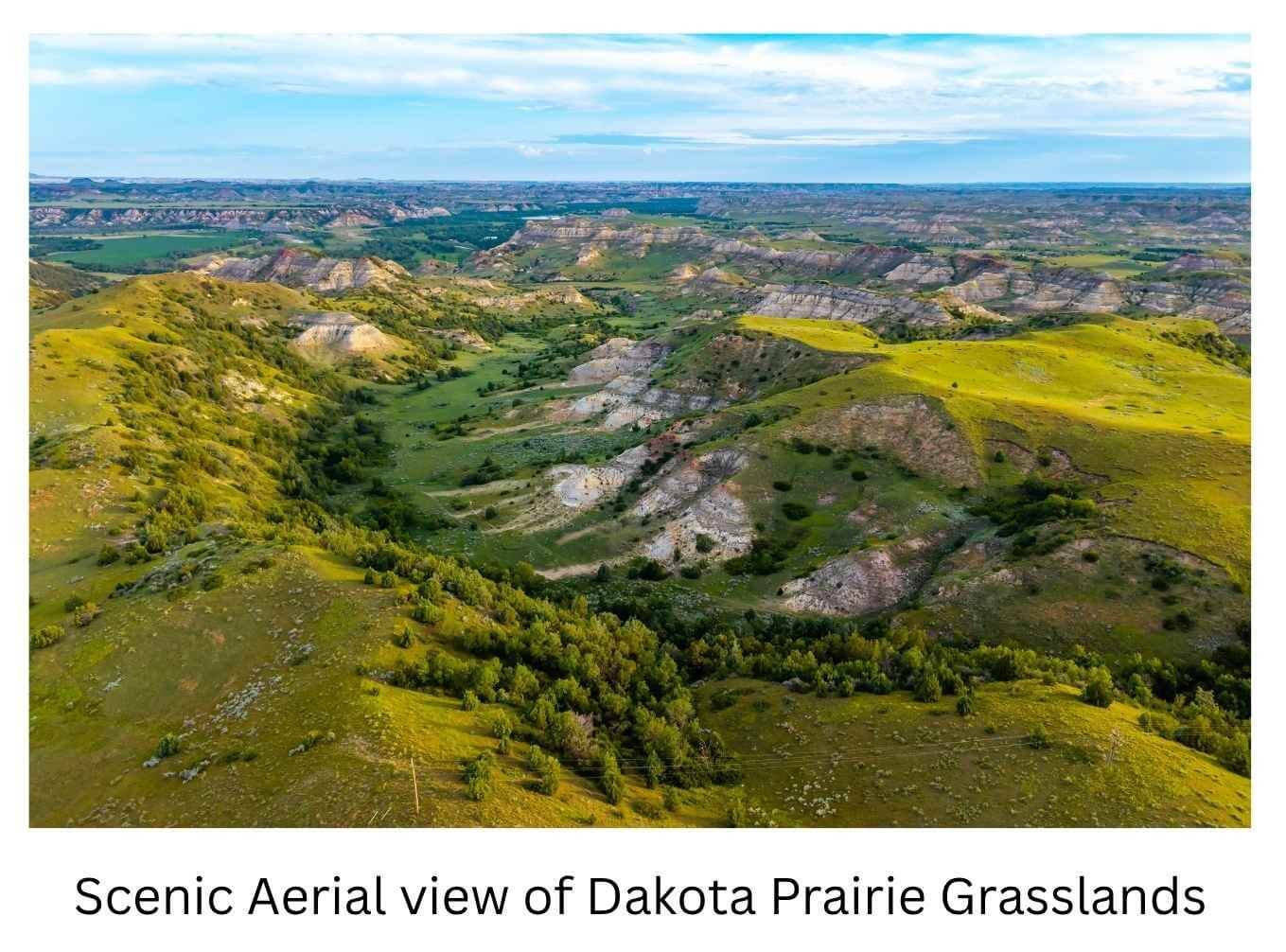Grassland ecosystems are expansive natural areas dominated by grasses with sparse trees and shrubs. This ecosystem exists in places where rainfall is too scarce as compared to forest ecosystems but more rainfall compared to deserts. Grasslands are characterized by open, expansive spaces, rich soil, and occasional fires which are important in sustaining the ecological balance by hindering tree invasion.

The main features of grassland ecosystems are:
It is dominated by herbaceous plants, especially grasses.
It always faces epic periodic disturbances like fire and grazing.
The ecosystem is characterized by a seasonal climate with wet and dry seasons.
Importance and worldwide distribution of Grassland Ecosystems
The Grassland ecosystem is one of the important carbon sinks, supports water cycling, and ensures food security via grain production and cattle ranching.
The Grassland ecosystem is present in every continent except Antarctica. It occupies approximately 40% of the world’s land surface and plays a vital role in hosting biodiversity.
Some of the important grassland ecosystem regions are-
- North American Prairies
- South American Pampas
- Eurasian Steppes
- African Savannas
- Australian Rangelands
Types of Grasslands
Different types of grasslands are mentioned below-
Tropical Grasslands or Savannas
This type of grassland is located in the equatorial region, and is characterized by a warm climate with wet and dry seasons. They are primarily found in East and Central Africa, Northern Australia, and some parts of South America. Tropical grasslands consist of sporadic trees and shrubs scattered within tall grasses. Savannas accommodate the seasonal growth of plants with timed rain and are prone to periodic fires.

Temperate grasslands (Prairies, pampas, and Steppes)
Temperate grassland is located in mid-latitude areas with warm summers and cold winters. The region gets moderate precipitation which is sufficient to grow grasses but not enough to grow entire forests. Examples of Temperate grasslands include the Prairies of North America, the Pampas of South America, and the Steppes of Eurasia.

Montane grasslands and flooded Grasslands
Montane grasslands- These are found in high-elevated mountainous areas, they are subjected to lower temperatures and greater winds. Montane grasslands are found in the Himalayan region, Andes region, and East African Highlands.
Flooded grasslands- These grasslands have special vegetation that is tolerant of wet conditions and are periodically flooded by water. For example the Pantanal of South America and Sudd of Africa.
Climate and Environmental conditions of Grassland Ecosystems
Precipitation and Temperature
Grasslands have variations in precipitation and temperature depending upon their type and location. The temperature in Tropical grasslands ranges between 20C to 30C with seasonal rainfall ranging between 500-1500 mm per annum. Temperate grasslands have greater seasonal fluctuation with hot summers and cold winters and rainfall ranging between 250-900 mm per year.
Soil composition and fertility
Grassland soil is high in organic content due to the decomposition of grassroots. Temperate grassland regions are nourishing, rich in nutrients, oxygen-rich can hold water and are suitable for farming, but Savanna soils are of lower fertility and need to be improved for farming.
Vegetation of Grassland Ecosystems
The most dominant vegetation in the grassland ecosystem is the grasses. Some of the common genera include Andropogon spp., Poa spp., Cynodon spp., Bouteloua spp., and Festuca spp. These grasses show adaptations such as thin leaves for reducing water loss, deep root systems to prevent erosion, rapid growth, and wind-dispersed seeds. These adaptations allow grasses to thrive during unfavorable conditions such as periodic fire, and climate fluctuations.
Role of wildflowers and other herbaceous plants
Wildflowers and other herbaceous plants also enhance the ecological function of grassland ecosystems. Flowering plants such as asters, milkweed, and goldenrod are attractive to pollinators. Legumes such as clover and alfalfa also fix nitrogen, thus making it more fertile. Forbs and ground cover help in holding soil in place to enhance drought resilience. These non-grassy plants enhance the health of the grassland ecosystem through greater biodiversity, enhanced pollination, and nourishment of below-ground microbial communities.
Fauna of Grassland Ecosystems
Grassland ecosystems accommodate a diverse variety of animal life, especially herbivores. In Tropical Savannas, animals such as elephants, zebras, giraffes, and different antelope species are seen in huge herds, migrating according to seasonal variations, whereas in temperate grasslands, wild horses, pronghorns, and bison are seen. These herbivores help maintain grassland biodiversity by suppressing the encroachment of woody plants and triggering renewed plant growth with grazing.
Predators and their ecological roles
Predators are also part of grassland food webs. African Savannas have top predators such as lions, cheetahs, hyenas, and leopards that maintain herbivore numbers under control and support balanced ecosystems. Other grasslands have predators such as wolves, coyotes, foxes, and birds of prey such as eagles and hawks. The carnivores ensure population regulation to evade overgrazing and habitat degradation. Grassland bird species are very specialized and diverse. Ground-nesting birds such as the greater prairie chicken, secretary bird, bustards, pipits, and larks depend on grasslands for cover and food. Most of these birds are sensitive to disturbance and are useful indicators of the state of the environment.
Ecological Functions and Services of Grassland Ecosystems
Grassland ecosystems offer various significant ecological functions that support natural systems as well as human society which are as follows-
Carbon sequestration deeply rooted grasses characteristic of these ecosystems sequester carbon in below-ground biomass and soil organic matter. This store of carbon is important in balancing greenhouse gas emissions, supporting significantly in mitigating climate change. Though grasslands are less spectacular than forests, they have longer-lasting and sometimes extra-stable soil carbon storage under some environmental conditions.
Water regulation and filtration– One more fundamental service is water regulation and filtration. Grassland soils are generally porous, allowing rainfall to soak through the soil profile and fill groundwater aquifers. Deposits and impurities are separated in the process, making the water cleaner downstream. With good grasslands, the probabilities of surface runoff, erosion, and flooding are significantly reduced owing to grass cover and root system of grasses.
Soil conservation- Grasslands are also significant in soil conservation. The dense networks of roots hold the soil in place, avoiding erosion from water and wind. Grasslands in dry and semi-dry areas serve as a resistance against desertification. Grasslands also have pollination services provided through habitat for numerous insects like bees, butterflies, and beetles. These pollinators are not only vital for the reproduction of native plant species but also for the neighboring crops. Generally, biodiversity contributes to the resilience and sustainability of ecosystems.
Human impacts on grassland ecosystems
Grassland ecosystems are one of the most disturbed and vulnerable biomes. One of the major causes of grassland degradation is agricultural expansion. Grasslands are usually present in flat and fertile lands so they are transformed into agricultural fields for cereal cultivation or for the extensive grazing of livestock. Such conversion breaks indigenous vegetation, causes loss of biodiversity, and changes soil and hydrological processes.
Infrastructure construction and urbanization also play an important role in habitat fragmentation. Industrial developments, roads, and energy infrastructure like wind farms and pipelines fragment grasslands, disrupting patterns of wildlife movement and triggering edge effects that cause a shift in plant and animal communities.
Overgrazing, particularly by domesticated livestock such as cattle, goats, and sheep, is one more important threat. Excessive grazing exceeds the land’s carrying capacity and affects the elimination of the vegetation cover, soil compaction, and the establishment of unpalatable or non-native vegetation. This variability minimizes the efficiency and resistance of grasslands and transforms them into degraded or desertified land.
Conservation and sustainable management
Protection and re-establishment of the grassland ecosystem needs to be a multi-faceted effort that involves science, policy, and local communities. Creating protected areas, comprising national parks, wildlife reserves, and biosphere zones, is a vital major step. These protected areas act as sanctuaries for indigenous vegetation and wildlife, providing them with an environment to survive devoid of agricultural or industrial pressure. However numerous grassland ecosystems are understated in the world’s protected zone.
Re-establishment projects are essential for reversing the effect of earlier land-use activities. These projects usually include replantation of native grasses, managing invasive plants, and restoration of primary herbivores or predators to restore ecological balance. Re-established grasslands recover not only their ecological roles but also offer ecosystem services such as water regulation and carbon sequestration.
Community-based conservation initiatives involve local communities in decision-making and sharing benefits. These initiatives tend to be effective in boosting sustainable grazing, eco-tourism, and land stewardship practices. By connecting economic incentives with ecological objectives, people become long-term conservation partners.
On the policy level, global and regional treaties such as the Convention on Biological Diversity (CBD), UN Convention to Combat Desertification (UNCCD), and several national conservation acts provide legal and institutional agendas for grassland protection. Applying these policies efficiently, however, involves funding, political will, and coordination amongst governments, NGOs, and stakeholders.
The Prospect of Grassland Ecosystems
The prospect of grassland ecosystems under climate change and rising human needs will depend on anticipatory and science-informed management.
Developments in remote sensing, GIS mapping, and ecological modeling now make it possible to monitor grassland health and dynamics more efficiently. These tools have the potential to identify areas of conservation need, monitor wildlife immigration, and measure the influence of various land-use methods.
To ensure the future of grasslands, it is essential to embrace a broad policy involving education, restoration, conservation of biodiversity, and policy mainstreaming. Community campaigns can change approaches towards grasslands, highlighting their ecological value beyond agriculture. Integrating indigenous knowledge, sustainable livelihoods, and responsible tourism are all components of an idealistic grassland management strategy.
Conclusion
Grassland ecosystems, even though often neglected in comparison to forests or wetlands, are critical components of the biosphere of the Earth. They harbor a rich diversity of fauna and flora, offer critical ecological services like carbon sequestration, water purification, and soil protection, and support human livelihoods through agriculture and grazing. These ecosystems are increasingly threatened by land-use transformation, overgrazing, urbanization, and climate change. The progressive deterioration of grasslands poses threats to not just biodiversity but also to global ecological equilibrium and food security.
Preservation and restoration of grasslands require an integrated approach that combines ecological understanding, sustainable land management practices, effective policy frameworks, and active community participation. By understanding the inherent and utilitarian value of grasslands, societies can act to conserve and utilize them sustainably. The future of grassland ecosystems hinges on our capacity to reconcile human needs with ecological integrity so that these landscapes remain productive for the future.
References
- Smith, & MB, J. (2025, April 14). Grassland | Definition, Animals, Plants, Climate, & Facts. Encyclopedia Britannica. https://www.britannica.com/science/grassland
- Grassland Ecosystem – Ecosystem structures & functions. (n.d.). https://ebooks.inflibnet.ac.in/esp01/chapter/197/
- Scholtz, R., & Twidwell, D. (2022). The last continuous grasslands on Earth: Identification and conservation importance. Conservation Science and Practice, 4(3). https://doi.org/10.1111/csp2.626
- Aithor. (2024, June 17). The flora and fauna of grassland ecosystems. aithor.com. https://aithor.co.in/essay-examples/the-flora-and-fauna-of-grassland-ecosystems
- The grassland biome. (n.d.). https://ucmp.berkeley.edu/exhibits/biomes/grasslands.php
- Bai, Y., & Cotrufo, M. F. (2022). Grassland soil carbon sequestration: Current understanding, challenges, and solutions. Science, 377(6606), 603–608. https://doi.org/10.1126/science.abo2380
- Liu, Y., Zhang, M., Zhao, Y., Wei, J., Zhou, S., & Shi, X. (2025). Effect of environmental factors on grassland biodiversity and biomass in the Zhangye region. Agronomy, 15(2), 476. https://doi.org/10.3390/agronomy15020476
- Lark, T. J. (2020). Protecting our prairies: Research and policy actions for conserving America’s grasslands. Land Use Policy, 97, 104727. https://doi.org/10.1016/j.landusepol.2020.104727
- NDCs, F. F. (2024, October 16). Implementing improved management practices in grasslands – Food Forward NDCs. Food Forward NDCs. https://foodforwardndcs.panda.org/food-production/implementing-improved-management-practices-in-grasslands/
- Testbook. (2024, February 5). Grassland Ecosystem – Components, types, functions & more | UPSC. Testbook. https://testbook.com/ias-preparation/grassland-ecosystem-components-structure-and-importance
- NASA Earth Observatory. (n.d.). Grassland: Mission: Biomes. https://earthobservatory.nasa.gov/biome/biograssland.php
